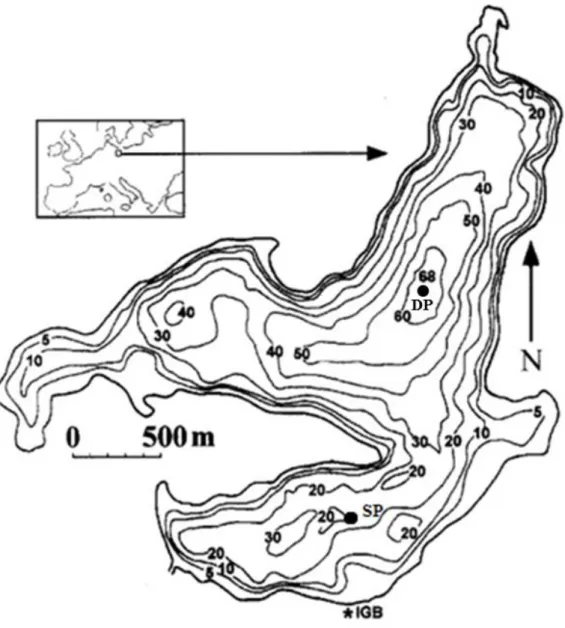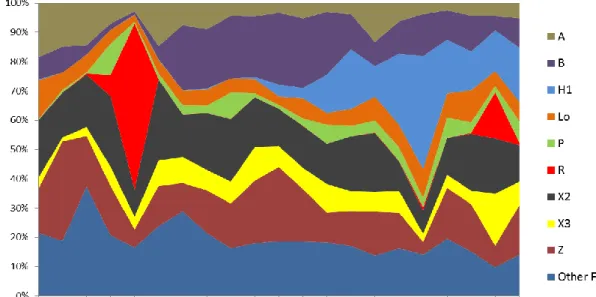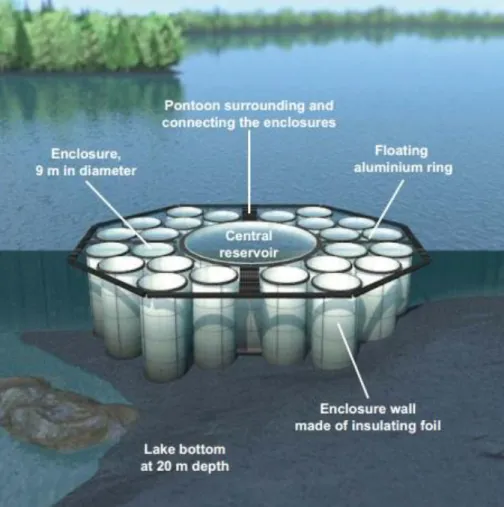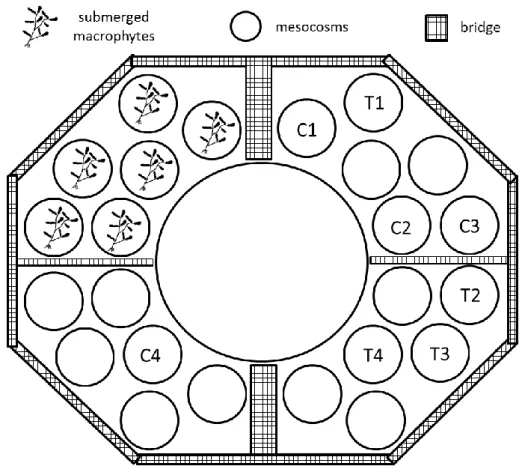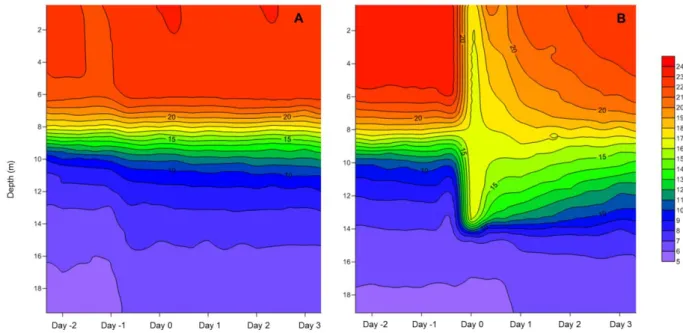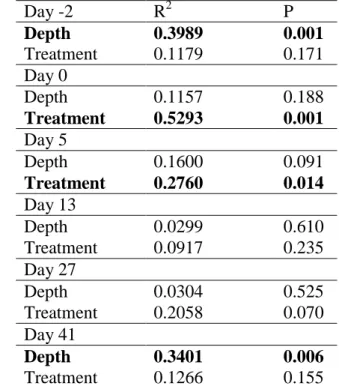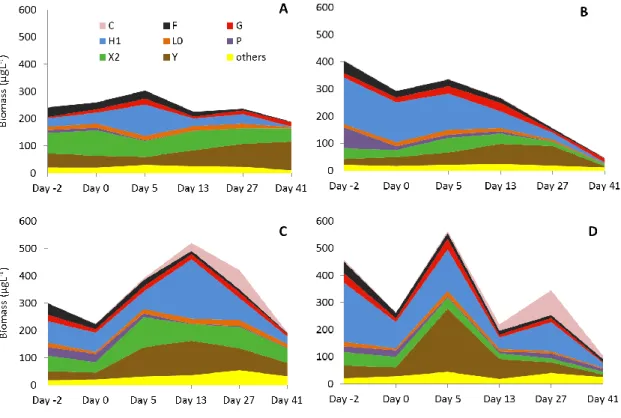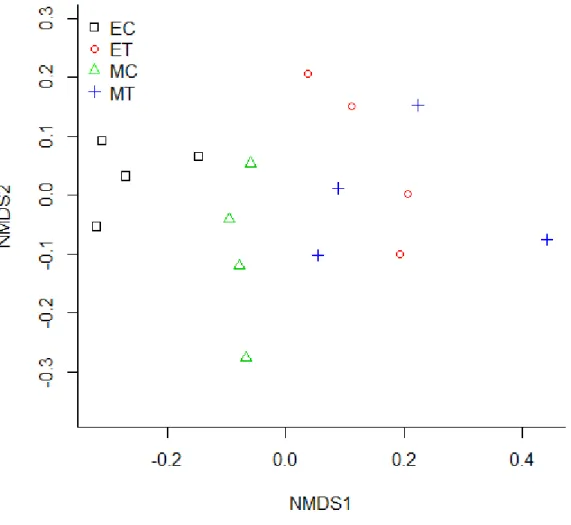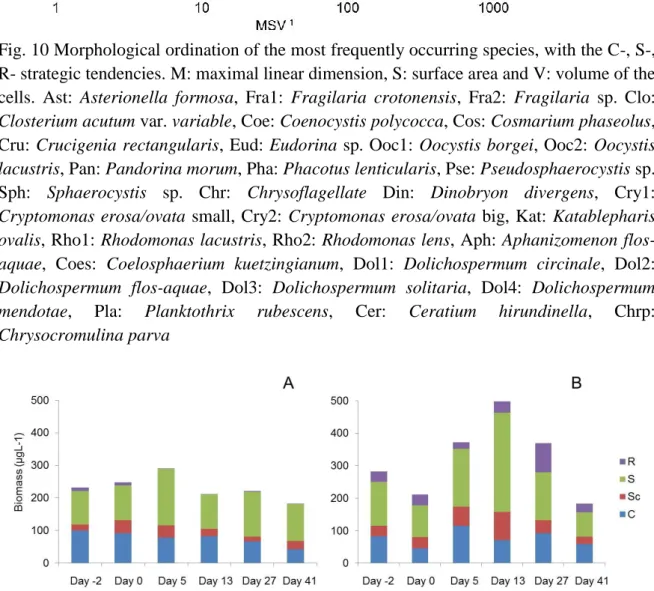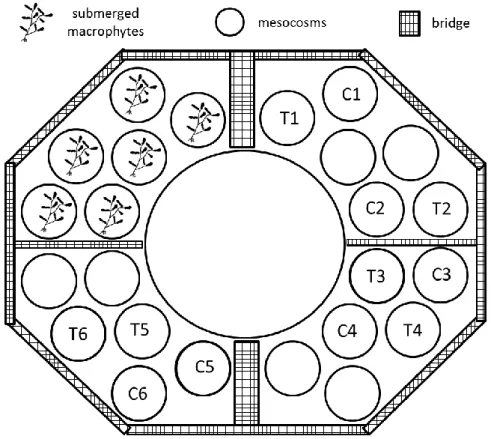University of Pannonia, Department of Limnology
Doctoral School of Chemistry and Environmental Sciences
_________________________________________________________________________
Biodiversity of phytoplankton in Lake Stechlin (Germany)
Ph.D. dissertation Géza Balázs Selmeczy
2017
DOI:10.18136/PE.2017.645
Biodiversity of phytoplankton in Lake Stechlin (Germany)
Írta:
Selmeczy Géza Balázs
Készült a Pannon Egyetem Kémiai és Környezettudományi Doktori Iskolája keretében Témavezető: Prof. Dr. Padisák Judit
Elfogadásra javaslom (igen/nem)
………..………..
(aláírás) Konzulens: Dr. habil. Lothar Krienitz
I suggest to accept (yes/no)
………..………..
(signature) A jelölt a doktori szigorlaton………%-ot ért el.
Az értekezést bírálóként elfogadásra javaslom:
Bíráló neve:………. igen/nem
………..………..
(aláírás
Bíráló neve:………. igen/nem
………..………..
(aláírás)
A jelölt az értekezés nyilvános vitáján ………%-ot ért el.
Veszprém,
………..………..
A Bíráló Bizottság elnöke
A doktori (PhD) oklevél minősítése ………
………..………..
Az EDHT elnöke
Cover photo: Géza B. Selmeczy (Lake Stechlin, Germany, 2013)
Submitted with 101 pages and 216 references The Dissertation contains 29 Figures and 9 Tables
Supervisors
Prof. Dr. Judit Padisák DSc, Head of Department, Department of Limnology, University of Pannonia, Veszprém, Hungary
Dr. habil. Lothar Krienitz DSc, Head of the Algological group, Department of Experimental Limnology, Leibniz-Institute of Freshwater Ecology and Inland Fisheries, Neuglobsow, Germany
“Und nun setzten wir uns an den Rand eines Vorsprungs und horchten in die Stille.
Sie blieb, wie sie war: kein Boot, kein Vogel; auch kein Gewölk.
Nur Grün und Blau und Sonne.”
Theodor Fontane Wanderung durch die Mark Brandenburg
Contents
Abbreviations ... 7
List of Figures ... 8
List of Tables ... 11
Summary ... 12
Kivonat ... 13
Zusammenfassung ... 14
1. Introduction ... 16
1.1. Lake Stechlin ... 16
1.2. Phytoplankton succession in Lake Stechlin... 18
2. Significance of the study ... 21
3. Thesis objectives ... 22
4. Materials and Methods ... 24
4.1. Phytoplankton analyses ... 24
4.2. Mesocosms ... 24
4.3. Statistical analyses ... 25
5. Results ... 27
5.1. Effect of a simulated extreme weather event on the summer phytoplankton assemblage of Lake Stechlin ... 27
5.1.1. Specific introduction ... 28
5.1.2. Specific materials and methods ... 29
5.1.3. Results ... 31
5.1.4. Discussion ... 37
5.2. Effect of the deepened summer stratification on the summer phytoplankton assemblage of Lake Stechlin ... 40
5.2.1. Specific introduction ... 41
5.2.2. Specific materials and methods ... 42
5.2.3. Results ... 43
5.2.4. Discussion ... 50
5.3. Toxin production in Lake Stechlin... 53
5.3.1. Specific introduction ... 54
5.3.2. Specific materials and methods ... 54
5.3.3. Results ... 57
5.3.4. Discussion ... 61
5.4. Spatial-and niche segregation in Lake Stechlin ... 64
5.4.1. Specific introduction ... 65
5.4.2. Specific material and methods ... 65
5.4.3. Results ... 66
5.4.4. Discussion ... 74
6. General discussion and further perspectives ... 78
6.1. Climate change and the phytoplankton community of Lake Stechlin ... 78
7. Acknowledgements ... 81
8. References ... 82
9. Thesis points ... 95
10. List of Publication ... 97
10.1. Publication related to the Dissertation ... 97
10.2. Other publications ... 98
10.3. Edition of books ... 99
11. Appendix ... 100
7
Abbreviations
AMT: aminotransferase
APP: autotrophic picoplankton DCM: Deep Chlorophyll maximum DHB: Dihydroxybenzoic acid DIN: Dissolved inorganic nitrogen IV: Indicator value
NMDS: Non-metric multidimensional scaling NPP: Nuclear Power Plant Rheinsberg PCR: polymerase chain reaction RWCS: Relative water column stability SRP: Soluble reactive phosphorus SRSi: Soluble reactive silica TP: Total Phosphorus TN: Total Nitrogen
8
List of Figures
Fig. 1 Bathymetric map of Lake Stechlin with the location of mesocosms (SP) and the deepest point (DP) (after Casper, 1985)
Fig. 2 The most frequently occurring functional groups in Lake Stechlin between 1994 and 2014
Fig. 3 Accumulating cyanobacteria records in Lake Stechlin 1994-2014 Fig. 4 Design of the LakeLab in Lake Stechlin (after Bauchrowitz, 2012)
Fig. 5 Lake Lab platform during the experiment of extreme weather simulation, C1, C2, C3, C4 indicate control mesocosms and T1, T2, T3, T4 indicate treated mesocosms
Fig. 6 Depth profiles of temperature in (C°) A: a control enclosure (E1) and B: a mixed enclosure (E16)
Fig. 7 DIN/SRP ratios in the mesocosms
Fig. 8 Average biomass of the most dominant functional groups during the experiment (A: Epilimnion of control mesocosms, B: Metalimnion of control mesocosms, C:
Epilimnion of treatment mesocosms, D: Metalimnion of treatment mesocosms) Fig. 9 Ordination of the phytoplankton community during the first sampling event (day
0). EC: Epilimnion of control mesocosms, ET: Epilimnion of treatment mesocosms, MC: metalimnion of control mesocosms, MT: metalimnion of treatment mesocosms
Fig. 10 Morphological ordination of the most frequently occurring species, with the C-, S- , R- strategic tendencies. M: maximal linear dimension, S: surface area and V:
volume of the cells. Ast: Asterionella formosa, Fra1: Fragilaria crotonensis, Fra2:
Fragilaria sp. Clo: Closterium acutum var. variable, Coe: Coenocystis polycocca, Cos: Cosmarium phaseolus, Cru: Crucigenia rectangularis, Eud: Eudorina sp.
Ooc1: Oocystis borgei, Ooc2: Oocystis lacustris, Pan: Pandorina morum, Pha:
Phacotus lenticularis, Pse: Pseudosphaerocystis sp. Sph: Sphaerocystis sp. Chr:
Chrysoflagellate Din: Dinobryon divergens, Cry1: Cryptomonas erosa/ovata small, Cry2: Cryptomonas erosa/ovata big, Kat: Katablepharis ovalis, Rho1:
Rhodomonas lacustris, Rho2: Rhodomonas lens, Aph: Aphanizomenon flos- aquae, Coes: Coelosphaerium kuetzingianum, Dol1: Dolichospermum circinale, Dol2: Dolichospermum flos-aquae, Dol3: Dolichospermum solitaria, Dol4:
Dolichospermum mendotae, Pla: Planktothrix rubescens, Cer: Ceratium hirundinella, Chrp: Chrysocromulina parva
Fig. 11 Average biomass of C-, S-, R-, primary strategies of phytoplankton during the experiment (A: Epilimnion of control mesocosms, B: Epilimnion of treatment mesocosms)
9
Fig. 12 Lake Lab platform during the experiment of deepened summer stratification, C1, C2, C3, C4, C5, C6 indicate control mesocosms and T1, T2, T3, T4, T5, T6 indicate treated mesocosms
Fig. 13 Typical temperature profiles of treatment (A) and control (B) mesocosms. The blue triangles indicate the pumping activity
Fig. 14 Average SRP values during the experiment in the epilimnion (upper panel) and in the hypolimnion (lower panel), S1: 29.05, S2: 25.06, S3: 10.07, S4: 23.07, S5:
06.08, S6: 20.08; C indicates control, T indicates treatment mesocosms
Fig. 15 Average DIN values during the experiment in the epilimnion (upper panel) and in the hypolimnion (lower panel), S1: 29.05, S2: 25.06, S3: 10.07, S4: 23.07, S5:
06.08, S6: 20.08; C indicates control, T indicates treatment mesocosms
Fig. 16 Average biomass of the different taxonomic groups during the experiment (A:
Epilimnion of treatment mesocosms, B: Hypolimnion of treatment mesocosms, C:
Epilimnion of control mesocosms, D: Hypolimnion of control mesocosms)
Fig. 17 Average biomass of the most dominant functional groups during the experiment (A: Epilimnion of treatment mesocosms, B: Hypolimnion of treatment mesocosms, C: Epilimnion of control mesocosms, D: Hypolimnion of control mesocosms)
Fig. 18 Boxplot of biomass of codon C, X3 and R in epilimnetic and hypolimnetic samples
Fig. 19 NMDS ordination diagram based on the functional group composition of the samples. E= Epilimnetic samples, H=Hypolimnetic samples
Fig. 20 Phytoplankton biomass in Lake Stechlin during 2011 and 2012. (µgL−1)
Fig. 21 Average biomass of Planktothrix rubescens, Planktothrix agardhii (A);
Microcystis cf. aeruginosa (B); and Dolichospermum spp. (C) between 2009 and 2013 in Lake Stechlin. I, II, III, and IV stand for quarters of years
Fig. 22 Ratio of pelagic phytoplankton communities in July 2011 (A) and November 2012 (B).
Fig. 23 Relative water column stability values and depth profiles of temperature (°C) in the south basin of the lake from 22 April 2013 to 11 November 2013
Fig. 24 Monthly average phytoplankton biomass and Aphanizomenon flos-aquae, Planktothrix rubescens and Cyanobium sp. in Lake Stechlin (station DP) during 2013 (diamond: total biomass, square: Aphanizomenon flos-aquae, triangle:
Planktothrix rubescens, circle: Cyanobium sp.
Fig. 25 Depth profiles of Aphanizomenon flos-aquae, Planktothrix rubescens, and Cyanobium sp. biomass (µgL−1), temperature and TP, SRP, DIN gradient in the deepest point of Lake Stechlin (DP) at different dates. A, B: 07 May 2013; C, D:
04 June 2013; E, F: 09 July 2013; G, H: 08 August 2013; I, J: 03 September 2013
10
Fig. 26 Depth profiles of cyanobacterial biomass (phycocyanin (µgL−1)) in south basin of Lake Stechlin (station SP) from 22 April 2013 to 11 November 2013 (the white line indicates the border of the epilimnion and metalimnion)
Fig. 27 Cyanobacterial biomass, estimated as phycocyanin and oxygen saturation data in different depths between May and September 2013 in the south basin of Lake Stechlin (SP)
Fig. 28 Striped regions indicate light intensity where Aphanizomenon flos-aquae (35-55 µmol m-2 s-1) Planktothrix rubescens (2-4 µmol m-2 s-1) reached its maximum biomass in the south basin of Lake Stechlin (SP)
Fig. 29 Ordination of some environmental parameters and phytoplankton species at different sampling dates and depths based non-metric multidimensional scaling (NMDS). Every symbol represents one sample: green circles if Cyanobium sp., blue triangles if Aphanizomenon flos-aquae and red squares if Planktothrix rubescens had the highest biomass
11
List of Tables
Table 1 Some physical and chemical variables in Lake Stechlin (average of 2014 in the euphotic zone)
Table 2 Summary of analyses of dissimilarities by categories. Significantly different categories are highlighted in bold
Table 3 Most important representatives of the main functional groups
Table 4 Summary of analyses of variance using distance matrices (ADONIS) testing the individual and joint effects of month, treatment and depth on community composition
Table 5 Summary of indicator coda of given months
Table 6 P- and N-concentrations; physical properties in July 2011 and November 2012 Table 7 Microcystin variants and contents detected in field samples and cyanobacterial
strains from Lake Stechlin, (n.d.: not detected)
Table 8 DIN/SRP ratio at deepest point of Lake Stechlin (DP)
Table 9 Species list of the mesocosms in the experiments in 2013 and 2014
12
Summary
Terrestrial and aquatic ecosystems are affected by the global climate change, which will accelerate according to most of the climate scenarios. The main goal of the work was to explore some processes related to climate change, which affect the phytoplankton assemblages and biodiversity of Lake Stechlin, such as extreme weather events during summer or changes of stratification pattern.
The main results of the work:
(1) The possible effects of global climate change on the phytoplankton community were studied in the LakeLab facility in Lake Stechlin. The mixing effect of the wind of an extreme summer storm was simulated, because these events are forecasted to increase both in frequency and intensity in the future. Increased amount of nutrients, decreased amount of phytoplankton biomass and water temperature were observed immediately after the treatment. After that, X2 and Y functional groups, then H1 codon dominated in the waterbody. In accordance with the results, summer storms can have a major effect on phytoplankton community dynamics and may transfer to higher trophic levels, thus are likely to impact sedimentation rates and further cascade to biogeochemical cycles of a given lake.
(2) The climate change is likely to result changes in the stratification because of the increasing temperature. Effects of experimentally deepened thermocline on the phytoplankton community were examined in the LakeLab during summer of 2013.
Remarkable amount of Planktothix rubescens were observed in the epilimnion of treatment enclosures as the most dominant cyanobacteria during the whole experiment. According to the results, a 2 meter deeper epilimnion than the average epilimnion had a significant effect on the phytoplankton community.
(3) During the last 15 years incidence and biomass of cyanobacteria increased substantially in Lake Stechlin that raised concern about potential toxicity. Microcystin and microcystin producing genes were detected first by our team in environmental samples from Lake Stechlin by toxicological and molecular analyses. It was proved, that toxins were produced by Microcystis cf. aeruginosa and Planktothrix rubescens present with low biomass, and not by the dominant Dolichospermum circinale and Aphanizomenon flos- aquae.
(4) During the analyses of depth distributed samples a rarely occurring deep chlorophyll maximum was observed with contribution of three species (Cyanobium, Planktothrix rubescens and Aphanizomenon flos-aquae), however with spatial segregation, which was very likely resulted by different environmental factors, such as light climate or nutrients availability, limiting them. This study shows a rare phenomenon, when phytoplankton species occur with spatial niche segregation close to equilibrium conditions.
These results indicate the necessity of careful calibration using fluorimetric techniques and the usefulness of parallel microscopic analyses during detection of cyanobacterial populations.
13
Kivonat
A globális klímaváltozás a terresztris és a vízi ökoszisztémákra is hatást gyakorol, mely a legtöbb szcenárió szerint a jövőben fokozódni fog. Az értekezés egyik fő célkitűzése volt a specifikusan a Stechlin-tó fitoplankton közösségére ható globális klímaváltozáshoz kötődő folyamatok minél jobb megismerése és részletes vizsgálata, úgymint a nyári extrém időjárási események vagy a rétegződési mintázatok megváltozásának hatása.
A dolgozat főbb, tudományos eredményei:
(1) A Stechlin-tóba telepített mezokozmoszokban vizsgáltam a globális klímaváltozás néhány lehetséges hatását a fitoplankton közösségre. A 2014 nyarán végzett kísérlet során egy extrém időjárási eseményt (erőteljes szél hatása, nyári viharok során) szimuláltunk, mely események a jövőben a klímaváltozás hatására növekvő gyakorisággal és erősséggel prognosztizálhatók. A kísérlet során azonnali tápanyag növekedést tapasztaltunk, a fitoplankton biomassza és a vízhőmérséklet pedig csökkent. Ezt követően először az X2 és az Y funkcionális csoport, majd pedig a H1 csoport volt domináns. A vizsgálat eredményeivel összhangban megállapítható, hogy a nyári viharok jelentős hatással lehetnek a fitoplankton közösség dinamikájára, mely változás továbbadódhat a magasabb trofitási szintek felé, így befolyásolva az ülepedési rátát, vagy akár a tó biogeokémiai ciklusait is.
(2) A globális klímaváltozás a növekvő hőmérséklet révén a rétegződési mintázatok megváltozását is eredményezheti. Az említett mezokozmoszokban 2013 nyarán az átlagosnál mélyebb epilimnion hatását vizsgáltuk a fitoplankton közösségre. A kezelt mezokozmoszok epilimnionjában jelentős abundanciát ért el a Planktothix rubescens, mely egyben a domináns cianobaktérium faj volt a kísérlet során. Az eredmények azt mutatják, hogy szignifikánsan befolyásolja a közösséget az átlagosnál 2 méterrel mélyebb epilimnion.
(3) Az utóbbi 15 évben a cianobaktériumok fajszáma és biomasszája alapvetően növekedett a Stechlin-tóban, mely növelte a potenciális toxicitást. A Stechlin-tóból származó környezeti minták toxikológiai és genetikai vizsgálata során elsőként detektáltunk microcystint és microcystin termelő géneket, továbbá kimutattuk, hogy a toxinokat nem a domináns Dolichospermum circinale és Aphanizomenon flos-aquae termeli, hanem az igen kis biomasszával jelenlévő Microcystis cf. aeruginosa és Planktothrix rubescens.
(4) A Stechlin-tóból származó vertikális rétegminták elemzése során egy speciális mélyrétegi maximumot figyeltünk meg, melyet több faj (Cyanobium, Planktothrix rubescens és Aphanizomenon flos-aquae) alakított ki egyidejűleg, viszont térbeli elkülönüléssel, melynek legfőbb oka az őket limitáló különböző környezeti faktorok lehetnek. A vizsgálat során bemutattunk egy ritka esetet, melyben fitoplankton fajok térbeli niche szegregációja történik közel az egyensúlyi állapothoz. Rámutattunk arra, hogy cianobaktérium populációk vizsgálatakor a fluoreszcens módszerek alkalmazásakor elengedhetetlen a megfelelő kalibráció, valamint fontosak lehetnek a párhuzamosan történő mikroszkópos vizsgálatok is.
14
Zusammenfassung
Terrestrische und aquatische Ökosysteme werden vom weltweiten Klimawandel beeinflusst, der sich gemäß den meisten Klimaszenarien beschleunigen wird. Das Hauptziel der Arbeit war es verschiedene Prozesse zu untersuchen, die mit dem Klimawandel zusammen hängen und die die Phytoplanktongemeinschaften im Stechlinsee beeinflussen, unter anderem Extremwetterereignisse im Sommer oder Veränderungen der Stratifizierung.
Die wichtigsten Ergebnisse der Arbeit:
(1) Die möglichen Auswirkungen des globalen Klimawandels auf die Phytoplanktongemeinschaft wurden im Seelabor im Stechlinsee untersucht. Der Durchmischungseffekt des Windes während eines extremen Sommersturms wurde simuliert, da prognostiziert wird, dass derartige Ereignisse in der Zukunft an Häufigkeit und Intensität zunehmen werden. Erhöhte Mengen an Nährstoffen und geringere Mengen an Phytoplanktonbiomasse, sowie niedrigere Wassertemperaturen, wurden direkt nach der Simulation beobachtet. Anschließend dominierten die funktionellen Gruppen X2 und Y, gefolgt von Codon H1, den Wasserkörper. Aus diesen Ergebnissen geht hervor, dass Sommerstürme einen großen Effekt auf die Dynamik der Phytoplanktongemeinschaft haben und sich weiter auf höhere trophische Ebenen auswirken könnten, und in dessen Folge auch Auswirkungen auf die Kaskade von Sedimentationsraten bis hin zu biogeochemischen Stoffkreisläufen eines Sees wahrscheinlich wären.
(2) Der Klimawandel resultiert wahrscheinlich in einer Veränderung der Stratifizierung aufgrund der ansteigenden Temperatur. Im Sommer 2013 wurde im Seelabor der Effekt einer experimentell vertieften Thermokline auf die Phytoplanktongemeinschaft untersucht.
Beträchtliche Mengen von Planktothrix rubescens wurden im Epilimnion der behandelten Mesokosmen beobachtet und stellten die dominanteste Cyanobakterienart während des ganzen Experiments dar. In Anbetracht der Ergebnisse hat ein 2m tieferes Epilimnion im Vergleich zu einem durchschnittlichen Epilimnion einen signifikanten Effekt auf die Phytoplanktongemeinschaft.
(3) Während der letzten 15 Jahre sind das Vorkommen und die Biomasse von Cyanobakterien im Stechlinsee wesentlich angestiegen und schüren Bedenken über ihre potentielle Toxizität. Mikrozystin und mikrozystinproduzierende Gene wurden von unserem Team durch toxikologische und molekularbiologische Analysen erstmals in Umweltproben des Stechlinsees entdeckt. Es wurde nachgewiesen, dass die Toxine von Microcystis cf. aeruginosa und Planktothrix rubescens, welche nur in geringer Biomasse vorhanden waren, produziert wurden, und nicht von den dominierenden Dolichospermum circinale und Aphanizomenon flos-aquae.
(4) Bei der Analyse tiefenverteilter Proben wurde ein Tiefen-Chlorophyll-Maximum unter Beteiligung dreier Arten (Cyanobium, Planktothrix rubescens und Aphanizomenon flos-aquae) beobachtet, die jedoch räumlich voneinander getrennt vorkamen, höchstwahrscheinlich aufgrund unterschiedlicher limitierender Umweltbedingungen, wie z.B. des Lichtklimas oder der Nährstoffverfügbarkeit. Diese Studie zeigt ein seltenes
15
Phänomen, in dem Phytoplanktonarten räumlich getrennt nahezu unter Gleichgewichtsbedingungen vorkommen. Die Ergebnisse zeigen die Notwendigkeit einer sorgfältigen Kalibrierung unter Benutzung fluorometrischer Techniken, und den Nutzen paralleler Mikroskopanalysen zur Bestimmung von cyanobakteriellen Populationen.
16
1. Introduction 1.1. Lake Stechlin
Lake Stechlin is located in North-eastern Germany, roughly 100 km north from Berlin, in the Mecklenburg Lake District (53°10′N, 13°02′E; 59.9 m a.s.l.). The lake was formed by the Weichselian glaciation around 12000 years ago (Casper and Koschel, 1995). The landscape around Lake Stechlin shows ice age erosion: there are thousands of small hills and depressions in this area. The natural surface catchment area of Lake Stechlin amounts 12.4 km2 of which 80% are covered by forest. The vegetation in the catchment area is dominated by pine (Pinus sylvestris). The majority of the pine forest is manmade replacing the former beech forest. The native beech and beech-oak forests are preserved only in few small plots (Krausch, 1970). Lake Stechlin is located in one of the oldest German’s nature reserve (protected since 1938) called “Naturpark Stechlin-Ruppiner Land”, which protects 8760 ha.
The climate of this area is at the transition between temperate marine and temperate continental climate zones. The marine influence causes moderately warm summer seasons and relatively mild winters (Fraedrich et al., 2001). Precipitation and groundwater inflow are the two main water-supplies of Lake Stechlin. The yearly average precipitation is around 600 mm (Richter and Koschel, 1985) and the theoretical water retention time is more than 40 years (Holzbecher et al., 1999).
The surface area of Lake Stechlin is 4.25 km2. The lake is divided to four basins:
north, west, south and central basin. The basins have a relative small surface area (1.3, 1.1, 0.9 and 1.0 km2) and belong to the category deep lakes based on their relative depths (5.3%, 3.5%, 3.3% and 5.2%), which calculated as a ratio of the maximum depth as a percentage of the mean diameter of the lake at the surface (Håkanson, 1981). The maximum depth of the lake (69.5 m) is located in the north basin. In comparison, the maximum depths of other basins are 41, 35 and 59 m (Casper, 1985a). The mean depth of the lake is 23.3 m and the volume is nearly 97*106 m3. The length of the shoreline is 16.1 km. Bathymetric map of Lake Stechlin are given in Fig. 1 (after Casper, 1985a; Padisák et al., 2010) and Table 1 shows the physical and chemical characteristic of the lake.
Lake Stechlin is an oligo-mesotrophic, most of the years dimictic and in some years warm monomictic lake. Thermal stratification develops between April and June and the most stable stratification occurs around late July. In winter, an inverted stratification may form under the ice (Padisák, 2003a).
Anthropogenic influences altered the lake in different ways. During the Middle-Ages the most apparent human impact was reduction of forests (household use, glass industry).
The Polzow Canal was constructed during the 18th century in order to connect Lake Stechlin with the River Havel. It resulted in a drastic (approximately 110 cm) decline of groundwater table and the water level of the lake. The most intensively studied anthropogenic influence on Lake Stechlin was the construction of the Nuclear Power Plant Rheinsberg (NPP). The NPP operated from 1966 to 1989 and nearly 300,000 m3 cooling water per day were taken from the mesotrophic Lake Nehmitz, then pumped into Lake
17
Stechlin as heated cooling water. The canal connection between the two lakes allowed the water flow back to Lake Nehmitz. (Koschel and Adams, 2003). The effect of the cooling water circulation on the lake ecosystem has been complex and contradictory. It is caused an external nutrient loading, which provided an evident reason for eutrophication, however, the thermal pollution changed the stability and position of the thermocline, further decreased the retention time of the water body, and these effects counteracted eutrophication (Koschel and Casper, 1986; Koschel et al., 2002). During the non-stratified period the water retention time decreased to 335 days because of the pumping and during the thermal stratification the retention time was around 124 days, because only the epilimnion was involved in the cooling water circulation (Koschel et al., 1985).
Interestingly, there is an endemic freshwater whitefish in Lake Stechlin (Schulz and Freyhof, 2003), it is called Coregonus fontanae, also known as Stechlin cisco.
Fig. 1 Bathymetric map of Lake Stechlin with the place of mesocosms (SP) and the deepest point (DP) (after Casper, 1985a)
18
Table 1 Some physical and chemical variables in Lake Stechlin (average of 2014 in the euphotic zone)
1.2. Phytoplankton succession in Lake Stechlin
Investigation of phytoplankton started in 1959, when the Limnological Laboratory was founded on the shore of Lake Stechlin. Since then, numerous investigations on different issues of phytoplankton were performed such as species composition, temporal and spatial distribution of dominant species, cell number or biomass calculation, however these studies were carried out with different sampling frequencies. The first quantitative phytoplankton results were published by Büsse (1972) and Küchler (1981, 1982). Later, Casper (1985b) synthesised the periods of 1959-1962, 1963-1964, 1969-1972 and 1976- 1978. Continuous phytoplankton dataset is available from the mid of ‘90s. One of the recent study (Padisák et al., 2010) about the phytoplankton of Lake Stechlin encompasses the results from 1994 to 2008.
From 1994 until end of the last millennium monomodal phytoplankton succession was characteristic with a spring maximum, then a bimodal pattern more characteristic. The spring assemblages between 1994 and 1997 were dominated by members of Codon A.
Small centric diatoms such as Cyclotella tripartita and C. pseudocomensis are typical within this group (Padisák et al., 2010). After this period, species of codon B appeared in increasing amounts (Fig. 2). The dominant members were Stephanodiscus neoastraea, S.
alpinus and Aulacoseira islandica. During the summer, an epilimnetic and a meta- and/or upper hypolimnetic phytoplankton assemblage can develop because of the proper stratification pattern and light regime of Lake Stechlin. Phytoplankton community of the summer epilimnion was very diverse and until 2005 it was dominated by the members of Codon L0, such as Ceratium hirundinella or Peridinium umbonatum, further several species from the genera of Chroococcus, Radiocystis and Coelosphaerium. Additionally numerous chlorococcalean species, mainly from Codon F, appeared in the summer epilimnetic assemblages. In the twenty-first century, a rapid invasion by nostocalean cyanobacteria occurred in the lake (Fig. 3): a number of Aphanizomenon and
Parameter unit value
Secchi transparency m 6.8
Oxygen concentration mgL-1 10.5
Oxygen saturation % 93.5
pH 8.2
Chl-a μgL-1 1.7
TP mgL-1 0.016
SRP mgL-1 0.004
TN mgL-1 0.462
NO3-N mgL-1 0.032
NH4-N mgL-1 0.018
19
Dolichospermum species belonging to H1 group appeared and from 2008 became dominant over the members of L0 group. Rhodomonas lacustris and R. lens are two frequently occurring species during the whole year and they belong to codon X2. R. lens reaches the highest biomass during autumn in most of the years, however in 2016 both species were quite dominant in the spring assemblages (Judit Padisák, personal communication). Codon X3 is a stable part of the phytoplankton community and can be found at least one representative of the functional group in nearly every sample.
Gymnodinium helveticum and Katablepharis ovalis are the most important species in this group.
Fig. 2 The most frequently occurring functional groups in Lake Stechlin between 1994 and 2014
A deep-layer maximum by cyanobacteria occurs regularly in the meta- or in the upper hypolimnion, mainly by the picocyanobacterium, Cyanobium sp. as the main representative of Codon Z (Padisák et al., 1997) or occasionally by Planktothrix rubescens (Padisák et al., 2003b). Surprisingly, in 2013, Aphanizomenon flos-aquae was observed in the metalimnion (Tapolczai et al., 2013) with parallel presence of Cyanobium sp. and Planktothrix rubescens (Selmeczy et al., 2016).
20
Fig. 3 Accumulating cyanobacteria records in Lake Stechlin between 1994 and 2014
21
2. Significance of the study
Importance of the phytoplankton in aquatic ecosystems is unquestionable because of several reasons. Phytoplankton generates nearly half of the primary production of the biosphere (Field et al., 1998). This community affects the abundance and diversity of other aquatic organisms, moreover drives aquatic ecosystem functioning. Phytoplankton is very important in the biogeochemical cycle as well, because of the crucial role in the carbon fixation (Falkowski, 1994; Sabine et al., 2004) and oxygen production. Further, phytoplankton forms the base of the food-web structure. Most of the phytoplankton species are autotrophic, thus they provide the energy-flux to the higher trophic levels.
Phytoplankton is a very diverse group of biota. There are several thousands of species in both the marine and freshwater environments (Reynolds, 1996). Since the biodiversity strongly contributes to ecosystem functioning (Juhász-Nagy, 1993; Hooper et al., 2005; Balvanera et al., 2006), the biodiversity of phytoplankton is necessary to the resilience and proper functioning of the previously mentioned complex and important functions.
In spite of the long history of phytoplankton studies, our knowledge has been fragmented on the ecology of numerous species or special communities. Extending this knowledge is very important to understand and evaluate better the results of monitoring assessments, which is strongly related to the conservation of the biodiversity of phytoplankton and to sustaining or restoring the good ecological conditions of aquatic ecosystems.
Climate change has significant effects on the aquatic ecosystems, thus phytoplankton community dynamics will very likely be altered mediated through direct and indirect effects (Winder and Sommer, 2012).
Lake Stechlin originally is a deep, oligotrophic lake, and the phytoplankton community shows sensitivity to the effects of global climate change (Padisák et al., 2010), thus this lake provides exceptional opportunities to study the previously mentioned issues.
22
3. Thesis objectives
Objective 1: Study the possible effects of global climate change, specifically the effect of an extreme weather event, on the phytoplankton community of Lake Stechlin in mesocosm experiments
The main consequences of the global climate change are the temperature increase in the lower atmosphere and the more frequently occurring extreme weather events (eg.
IPCC, 2007). The possible effects of temperature increase are much more studied compared to the effects of extreme events, because of several reasons. One of the most important reasons is that studies of the impact of these events have started only recently (Jentsch et al., 2007). Further, it is rather hard to predict these meteorological events and taking samples short after, and nearly impossible taking samples before them. Thus experiments in mesocosm facilities may provide a deeper insight to understanding short- term impact of such events. Accordingly, the 1st thesis objective is to study (i) how the hydrological parameters (T, RWCS, SRP, DIN) of the lake will be affected by a simulated summer storm in large mesocosm facilities (ii) what will be the impact of these changes on the phytoplankton community, more preciously how will change the ratio of the species with different CSR life-strategies, and (iii) how will change the ratio of phytoplankton functional groups?
Objective 2: Study the possible effects of global climate change, specifically the altered summer stratification depth, on the phytoplankton community of Lake Stechlin in mesocosm experiments
As mentioned afore, according to IPCC (2007) the two main consequences of the global climate change are the temperature increase and the more frequently occurring extreme weather events. One, but probably the most important selective factor of phytoplankton species selection is the water column stability relative to other environmental factors such as light climate (Reynolds et al., 1983). According to forecasts, climate change is very likely have an impact on the stratification patterns, thus it may cause changes in the phytoplankton community composition as well. The depth of the thermocline was deepened by 2 m in a mesocosm experiment and the aim of the research was to study the effects of this hydrological change on the phytoplankton community.
Objective 3: Establishment algal, mainly cyanobacterial, cultures to detect cyanobacterial strains with genetic potential to produce microcystin or other cyanotoxins
Apart that Lake Stechlin is a distinguished site for ecological research, it is a well- known touristic place in northeastern Germany and during the summer a popular bathing- site. Hence, it is crucial to supplement our knowledge on cyanobacterial mass developments and potential toxin production in the lake. Thus, in this research I intended to answer the following questions: (i) is there any toxin producing gene related to cyanobacteria in environmental samples from Lake Stechlin and (ii) can we confirm the result of environmental samples with isolated strains?
23
Objective 4: Study the vertical distribution of the phytoplankton community of the lake during summer stratification
A continuous dataset of biomass and abundance of phytoplankton of Lake Stechlin is available from the beginning of 1990s (Padisák et al., 2010). Lake Stechlin is a deep, meso-oligotrophic lake, and metalimnetic or upper hypolimnetic phytoplankton populations were observed during most of the summers dominated mainly by the picocyanobacterium Cyanobium sp. or occasionally by the filamentous Planktothrix rubescens (Padisák et al., 2003a). Although the first reports of deep living populations of phytoplankton species appeared long time ago (ie. Juday, 1934), our knowledge about these populations is incomplete. Since the metalimnetic or upper hypolimnetic layers during stratification are relatively long-lasting and the limiting factors are few, summer stratification in lakes where extension of the euphotic region exceeds that of the mixed layer offer good opportunities to study the relation of environmental factors and the given population/s. Further because of the very limited number of species it could help to understand the competition between phytoplankton populations.
24
4. Materials and Methods 4.1. Phytoplankton analyses
Phytoplankton samples were taken and biomass was determined with the classical methodology by Utermöhl (1958) and Lund et al. (1958). Samples were collected from the deepest point of the lake and from the mesocosms according to the research question of the given project. The details of the sampling campaigns are shown in the specific materials and methods. Samples were preserved in Lugol’s solution and were stored in a dark place and at room temperature. Altogether 400 settling units (cells, filaments and colonies) were counted at minimum in each sample using an inverted microscope (Zeiss Axiovert 100, Oberkochen, Germany) microscope. Volume of the cells was calculated by the most similar geometric form according to Hillebrand et al. (1999), then biovolume was converted to biomass using the 1 mm3L-1 = 1 mgL-1 conversion factor. Opticount cell counting software (Opticount, 2008) was used to estimate the biomass.
Phytoplankton taxa were identified according to Fott (1968), Ettl et al. (1978), Ettl et al. (1985), Tikkanen (1986), Popovský and Pfiester (1990), Komárek and Anagnostidis (1998), Nagy-Tóth and Barna (1998), Komárek and Anagnostodis (2005), Komárek (2013).
4.2. Mesocosms
Within the TemBi (Climate changes impact on biodiversity of microbiota and matter- and energy-fluxes in lakes) project, an experimental setup consisting of 24 large-sized enclosures and a central reservoir was built in the south basin of Lake Stechlin (Bauchrowitz, 2012) (Fig. 4). This facility is called “LakeLab”. Diameters of the enclosures are around 9 m and their plastic walls are anchored to the bottom of the lake.
Since the bottom of the lake is not flat under the LakeLab, the depths of the enclosures varies between 17 and 20 m. Physical and chemical parameters (temperature, conductivity, pH, redox potential, oxygen concentration, oxygen saturation, and the photosynthetically available radiation—PAR), pigment concentrations of different algal groups (chlorophytes, cyanobacteria, diatoms, cryptophytes) and yellow substances are measured with a BBE (biological, biophysical, engineering) fluoroprobes and Yellow Springs Instruments (YSI) sensors. These instruments were installed in all enclosures and in the central reservoir too, additionally 4 instruments were placed in the lake around the LakeLab.
25
Fig. 4 Design of the LakeLab in Lake Stechlin (after Bauchrowitz, 2012)
4.3. Statistical analyses
For the statistical analyses, I used program R (R Core Team, 2013) with vegan package (Oksanen et al., 2015).
In Chapter 5.1: Community analyses were performed with non-metric multidimensional scaling (NMDS) method with Bray-Curtis dissimilarity index, and influence of factors on the community, such as depth or treatment, were analysed with a code in vegan package called envfit.
In Chapter 5.2: Analysis of variance using distance matrices, function ADONIS in R, was used to test how depth (epilimnion or hypolimnion), month of the sampling (June, July, August) and treatment (control, treatment) influence the community composition.
Bray-Curtis dissimilarity was used for the distance matrix. Indicator species analysis according to Dufrene and Legendre (1997) was run to identify characteristic taxa of depths, months and treatments. INDVAL function was used by the labdsv package (Roberts, 2012) in R environment.
In Chapter 5.4: Community analyses were performed with NMDS method with Bray-Curtis dissimilarity index, and the relationships of environmental variables and the phytoplankton community were assessed with envfit. Seven environmental variables (SRP, TP, DIN, TN, ratio of DIN/SRP, Depth, and T) were screened and those were accepted,
26
which had P-values of at least 0.01 (p values based on 999 permutation). For the analyses, biomasses were used without any preliminary transformation.
27
5. Results
5.1. Effect of a simulated extreme weather event on the summer phytoplankton assemblage of Lake Stechlin
1
1 This chapter is based on the following paper:
Selmeczy GB; Berger SA; Nejstgaard JC; GilingDP; GrossartHP; Kasprzak P; CasperP; GessnerMO;
Padisák J (in prep): Simulating an extreme weather event in large mesocosms: changes phytoplankton community dynamics and an example of the memory effect
28 5.1.1. Specific introduction
Potential effects of global climate change on aquatic ecosystems belong to the most frequently studied topics. Basically, there are two main consequences of global climate change: temperature increase in the lower atmosphere and increasing probability of extreme weather events (IPCC, 2007). According to some model projections (eg. Beniston et al., 2007), extreme events such as heat waves, heavy rainfalls, wind storms are expected to occur more frequently in the future as a characteristic feature of global warming.
However, most of the studies focus on the effect of temperature increase such as bias in spring bloom timing (Lassen et al., 2010) or mismatch between trophic levels and functional groups such as primary producers, copepods or meroplankton including fish larvae (Keller et al., 1999; Edward and Richardson, 2004). Temperature increase may affect phytoplankton directly through physiological processes while extreme weather events act mainly indirectly through terrigenous inputs or modifying mixing patterns with consequences on stratification pattern, nutrient availability or light conditions. Several mesocosm studies tested the effect of these factors on the phytoplankton community separately (e.g. Berger et al., 2007), and only a few experiments combined some of them (Graham and Vinebrooke, 2009; Nicolle et al., 2012).
Vertical mixing processes of a lake is defined mainly by climate and some morphological data (depth, fetch length, location, e.g.) of the lake (Borics et al., 2015). The composition of the phytoplankton assemblages of a given lake is significantly influenced by the mixing processes as they strongly influence the resource availability and entrainment strategies in the epilimnion. These processes can be altered by extreme weather events, thus these meteorological situations may strongly impact the hydrodynamics and the plankton assemblages (Anneville et al., 2010; Straile et al., 2010).
It has been widely accepted that changes in trophic levels have a great impact on standing crop of phytoplankton: with increasing P loadings mostly cyanobacteria become predominant. Proliferation of cyanobacteria has been a worldwide issue in many aquatic environments (Sukenik et al., 2015), and the ability of cyanobacteria to form blooms (Reynolds, 2006) and produce toxins (Carmichael, 2001) raise scientific and social interest.
The involved organisms belong to about 40 genera. In case of blooms of these species, the given environment can be negatively affected (Codd et al., 2005). However, proliferation of cyanobacteria is not an obligatory response to increasing P loadings: in many cases species belonging to other large phytoplankton groups may dominate (Medeiros et al., 2015). In contrast, composition of the phytoplankton assemblages of a given lake is largely determined by the physical environment selecting for functional traits adapted to the offered conditions (Zohary et al., 2010). There are several field observations showing that extreme weather events such as hurricanes (Havens et al., 2011; Beaver et al., 2013a), summer heat waves (Anneville et al., 2010; Gallina et al., 2011) droughts (Flanagan et al., 2009; García-Jurado et al., 2012) floods (Gong et al., 2011) alone or in combination (Beaver et al., 2013b) have strong impact on aquatic ecosystems. Observations in many cases are strongly related to monitoring systems with protocols prescribing frequent sampling. There is little information about the short-term effects, because study of the
29
impact of extreme weather events has started only recently (Jentsch et al., 2007).
Additionally, it is rather hard to predict these meteorological events and taking samples short after. Thus, experiments in mesocosm facilities may provide a deeper insight to study short-term impact of such events.
During late summer, the typical phytoplankton community is diverse and the total phytoplankton biomass could reach a second, lower peak after the clear water phase (Sommer et al., 2012) in deep, oligo-mesotrophic lakes such as Lake Stechlin. This summer community is consisted of numerous K-selected, S-strategist species, which are primarily acquisitive such as Ceratium hirundinella or larger species of Peridinium (Reynolds, 1997). Our hypothesis is that, if the stratification is broken or eroded by an extreme summer storm, several consequences can occur: (i) nutrient addition to the epilimnion from the deeper waters, (ii) decrease the number of S-strategist species, and (iii) increase the number of invasive C-strategist species in the short-term.
5.1.2. Specific materials and methods
Eight enclosures were randomly selected for the experiments excluding 6 mesocosms, which contained submerged macrophytes on the sediment (Fig. 5). Prior to the experiment, water exchange was performed in all mesocosm to reach similar initial conditions. First, the hypolimnetic water was changed, than the epi- and metalimnion. The mixing effect of a summer storm was experimentally simulated in 4 of the 8 mesocosms; the other four mesocosms served as controls. The mixing was performed by Flygt pumps during 4 hours.
The pumping capacity was 90 m3h-1. Epilimnetic and metalimnetic samples were taken two days before the experiment, immediately after the mixing, then 5, 13, 27, 41 days later to follow the short- and medium time-scale effects of the mixing.
30
Fig. 5 Lake Lab platform during the experiment of extreme weather simulation, C1, C2, C3, C4 indicate control mesocosms and T1, T2, T3, T4 indicate treated mesocosms
Physical and chemical parameters (temperature, conductivity, pH, redox potential, oxygen concentration, oxygen saturation and the photosynthetically available radiation - PAR) were measured with YSI (Yellow Springs Instruments) sensor. These data were recorded in half a meter intervals from the surface (0.5 m) to the bottom. Concentrations of TP, SRP, TN, NO2-
, NO3-
, NH4+
and SRSi were measured according to (APHA, 1998). All inorganic N fractions (NO2--N, NO3--N and NH4+-N) were added for estimating dissolved inorganic nitrogen (DIN), and nutrient ratio (DIN/SRP).
Relative water column stability (RWCS) (Welch, 1992) was calculated using the formula:
𝑅𝑊𝐶𝑆 =𝐷𝑏− 𝐷𝑠 𝐷4− 𝐷5
where Db is the density of the bottom water, Ds is the density of surface water and D4-D5 is the density difference between 4 and 5 °C water.
C-, S-, R- primary strategies of the 30 most frequently occurring species were determined according to the general morphological features of the species during the experiment. The classification based on a size and a shape descriptor of the species which were plotted on an X-Y graph. Shape descriptor was calculated as the maximal linear dimension and the surface-volume ratio along X axis, additionally size descriptor was
31
determined as the surface-volume ratio along Y axis. This method was adopted from Reynolds (1997).
5.1.3. Results
Two days prior to the experiment RWCS values of the mesocosms were rather similar: 312
± 7. The mixing nearly homogenised the top 14 m water column and the RWCS values strongly decreased in the treated enclosures (162 ± 8), however similar values (310 ± 3) were calculated in the control mesocosms than two days before. The temperature profiles of the control and treatment mesocosms during the beginning of the experiment are given on Figure 6.
Two days prior to the study, SRP values were strongly limiting both in the control and the treatment mesocosms (0.001 mgL-1). The amounts of SRP were near to detection limit in the control enclosures almost during the whole experiment, except the last sampling event (day 41) when 0.025 mgL-1 was measured in the metalimnion, however the epilimnetic concentration remained at 0.001 mgL-1. In the treatment mesocosms, SRP doubled both in the meta- and epilimnion (0.002 mgL-1), immediately after the mixing; 5 days later SRP values dropped to 0.001 mgL-1 again. The amounts of DIN varied between 0.009 mgL-1 and 0.029 mgL-1 in the epilimnion and between 0.016 mgL-1 and 0.043 mgL-1 in the metalimnion before to the study, then continuously decreased in the epilimnion of the control mesocosms. The lowest value of DIN (0.001 mgL-1) was measured 13 days after the mixing. The highest values were recorded immediately after the mixing in the epilimnion (0.074 mgL-1) and in the metalimnion (0.053 mgL-1) of the treatment enclosures. The DIN/SRP ratios varied between 1 and 44 during the experiment (Fig. 7).
Fig. 6 Depth profiles of temperature in (C°) A: a control enclosure (E1) and B: a mixed enclosure (E16)
32
Fig. 7 DIN/SRP ratios in the mesocosms
Cyanophytes, Cryptophytes and Chlorophytes were the most prominent taxonomic groups during the experiment. Altogether 128 taxa were found belonging to 21 functional groups. H1, Y and X2 were the most abundant coda. Dolichospermum flos-aquae (Brébisson ex Bornet & Flahault) Wacklin, D. circinale (Raberhorst ex Bornet & Flahault) Wacklin, D. solitarium (Klebahn) Wacklin and Aphanizomenon flos-aquae Ralfs ex Bornet
& Flahault were the most dominant members of codon H1, Cryptomonas erosa Ehrenberg and C. ovata Ehrenberg were present in significant amounts in Y codon and Rhodomonas lacustris Pascher & Ruttner, R. lens Pascher & Ruttner and Chrysochromulina parva Lackey were the main representatives of X2.
Two days prior to the experiment codon X2 was dominant in the epilimnion of control mesocosms, however Y and H1 were significant as well (Fig. 8A). Codon H1 was the most abundant functional group in the epilimnion of treatment enclosures (Fig. 8C), but X2, Y and F group were remarkable too. In spite of the slightly distinct proportions of
33
functional groups, there were no statistically significant differences between the experimental and control mesocosms before the experiment; however, the communities of epilimnion and metalimnion significantly differed (Table 2).
Table 2 Summary of analyses of dissimilarities by categories. Significantly different categories are highlighted in bold
Day -2 R2 P
Depth 0.3989 0.001
Treatment 0.1179 0.171
Day 0
Depth 0.1157 0.188
Treatment 0.5293 0.001 Day 5
Depth 0.1600 0.091
Treatment 0.2760 0.014 Day 13
Depth 0.0299 0.610
Treatment 0.0917 0.235
Day 27
Depth 0.0304 0.525
Treatment 0.2058 0.070
Day 41
Depth 0.3401 0.006
Treatment 0.1266 0.155
Prior to the experiment, H1 codon contributed nearly 50% of the total biomass in the metalimnion of each enclosure, thus it was the most dominant functional group (Fig. 8 B, D). Other groups were present in low abundance, which caused the significant difference from the epilimnetic community.
Within a few hours after the mixing event, the total biomass decreased by 12-42% in the epi- and metalimnion of the stirred enclosures. Further, the H1 dominance significantly decreased in the metalimnion, thus the epi and metalimnetic assemblages became fairly similar and consequently the phytoplankton community composition of treatment mesocosms differed significantly from the control mesocosms (Table 2). Control and treated mesocosms are separated on the NMDS ordination (Fig. 9), moreover, the epi- and metalimnion samples are mixed in case of treated mesocosms, however in the control enclosures the epi and metalimnion samples still appeared as two distinct groups.
On the 5th day after the mixing, the biomass started to increase and Y and X2 coda became the most frequently occurring members of the phytoplankton assemblages in the epilimnion and Y and H1 coda were prominent in the metalimnion of the treatment enclosures (Fig. 9). In the epilimnion of control mesocosms Dolichospermum species increased their biomass share in the community (14 - 44%).
On the 13th day after the mixing event the total biomass reached its maximum level in the epilimnion (718µgL-1 - 325µgL-1) paralleled with a sharp decrease in the metalimnion in the treatment mesocosms. During this sampling event, Dolichospermum
34
species dominated in the epilimnion, then continuously decreased in the treatment enclosures. In the epilimnion of control mesocosms H1 codon decreased and coda Y and X2 increased until the end of the experiment.
Surprisingly, two weeks later (day 27), the meta and epilimnion of enclosure T2 and T3 was dominated (between 20 and 41% of the total biomass) by Asterionella formosa Hassall, however, the biomass of this species was nearly negligible in the other two treated mesocosms (less, than 9% in Enclosure 5 and less, than 1% in Enclosure 13). During the last sampling event (day 41) the biomass reached minimum levels (148µgL-1 - 291µgL-1) and it was quite evenly distributed among H1, Y and X2 coda in the epilimnion and A.
formosa became rather rare again in the samples.
Fig. 8 Average biomass of the most dominant functional groups during the experiment (A:
Epilimnion of control mesocosms, B: Metalimnion of control mesocosms, C: Epilimnion of treatment mesocosms, D: Metalimnion of treatment mesocosms)
35
Fig. 9 Ordination of the phytoplankton community during the first sampling event (day 0).
EC: Epilimnion of control mesocosms, ET: Epilimnion of treatment mesocosms, MC:
metalimnion of control mesocosms, MT: metalimnion of treatment mesocosms
The 30 most frequently occurring phytoplankton species were divided to C-, S-, R- primary strategies according to the morphological features of the species. The C – S axis was divided into three categories: C, SC and S group (Fig. 10). Two days prior to the experiment C-, and S- species were dominant in the epilimnion both in the control and treatment mesocosms (Fig. 11 A, B). The clearly C-strategist species show a decreasing tendency in the control mesocosms and a fluctuating trend in the treatment ones.
Immediately after the treatment the total phytoplankton biomass decreased significantly, but the ratio of the different groups did not show notable changes. After 5 days C-, SC-, and S-strategists increased and C-strategist reach their maximum biomass. During the next sampling event (day 13) S group became dominant and reached a maximum level, after that it continuously decreased. The presence of R-strategist species were the most significant differences between the phytoplankton community of control and treatment mesocosms. This group reached their maximum biomass during day 27.
36
Fig. 10 Morphological ordination of the most frequently occurring species, with the C-, S-, R- strategic tendencies. M: maximal linear dimension, S: surface area and V: volume of the cells. Ast: Asterionella formosa, Fra1: Fragilaria crotonensis, Fra2: Fragilaria sp. Clo:
Closterium acutum var. variable, Coe: Coenocystis polycocca, Cos: Cosmarium phaseolus, Cru: Crucigenia rectangularis, Eud: Eudorina sp. Ooc1: Oocystis borgei, Ooc2: Oocystis lacustris, Pan: Pandorina morum, Pha: Phacotus lenticularis, Pse: Pseudosphaerocystis sp.
Sph: Sphaerocystis sp. Chr: Chrysoflagellate Din: Dinobryon divergens, Cry1:
Cryptomonas erosa/ovata small, Cry2: Cryptomonas erosa/ovata big, Kat: Katablepharis ovalis, Rho1: Rhodomonas lacustris, Rho2: Rhodomonas lens, Aph: Aphanizomenon flos- aquae, Coes: Coelosphaerium kuetzingianum, Dol1: Dolichospermum circinale, Dol2:
Dolichospermum flos-aquae, Dol3: Dolichospermum solitaria, Dol4: Dolichospermum mendotae, Pla: Planktothrix rubescens, Cer: Ceratium hirundinella, Chrp:
Chrysocromulina parva
Fig. 11 Average biomass of C-, S-, R-, primary strategies of phytoplankton during the experiment (A: Epilimnion of control mesocosms, B: Epilimnion of treatment mesocosms)
37 5.1.4. Discussion
Changes of the phytoplankton community largely depend on the water column stability relative to other environmental factors such as light climate. Isothermal mixing processes, during autumn and early spring, have a major role on conditioning the starting condition of the annual succession. Additionally, during the stratified period micro-stratification (for example, by convective mixing) is very important to set the ratio between the motile or buoyant self-regulating organisms and non-motile phytoplankton species. Thus, the mixing processes belong to the most important environmental factors driving the characteristic periodic cycles of the phytoplankton community in temperate lakes (Reynolds et al., 1983).
Mixing processes are affected by climate change, even in case of huge lakes such as Lake Baikal (Moore et al., 2009). Stronger stratification is very likely occur in the future, because of the higher air temperatures (Winder and Sommer, 2012), which is advantageous for motile species such as cyanobacteria or flagellates, because these species are able to stay in the epilimnion and avoid to sediment. Moreover, the higher water temperatures favour bloom-forming cyanobacteria, because many species exhibit higher maximum growth rates at higher temperatures compared to diatoms and green algae (Jöhnk et al., 2008). Water bodies in some cases can offer opportunities to development of deep living communities (Camacho, 2006), which can be made up of wide range of phytoplankton taxa (Selmeczy et al., 2016).
Extreme strong summer storms however may alter or break the stratification, and even if they are ephemeral events can have serious and spectacular consequences on the phytoplankton community, which was observed on Lake Stechlin during the summer of 2011 (Müller et al., 2016): during this summer Dolichospermum bloom was observed in Lake Stechlin, which led to a strong decrease of Secchi-depth because of a calcite precipitation.
During our experiment we wanted to mimic an extreme weather event and analyse the effect of the modified stratification pattern on the phytoplankton community structure.
The most important short term, within a few hours, consequence of the mixing was a sharp decrease of the biomass and the homogenization of the epilimnetic and metalimnetic community similarly to wind-induced stir-up in shallow lakes (Padisák et al., 1990). The most probably reason of the biomass drop is that the mixing reached the upper hypolimnion with lower biomass, which diluted the epi and the metalimnion.
Extreme summer storms can increase the available nutrients in the epilimnion as was observed in case of Lake Okeechobee (Beaver et al., 2013a), where the amount of SRP more than doubled during a post hurricane period. The increased level of nutrients may favour C-strategist species, which prefer the disturbed environments and appear after the onset of new hydrologic conditions (Reynolds, 1997). These species are characterised by relatively small cell size, fast replication and by rapid nutrient absorption. Typical representatives belong to X and Z associations such as Ankyra, Chlamydomonas or Rhodomonas (Reynolds, 1997). In our experiment C-strategist species were present both in the control and treatment mesocosms during the whole experiment, however they reached their maximum level 5 days after the mixing event, which support the expectation based on the conception of C-S-R life strategies. That time, Rhodomonas lacustris was the main
38
representative of the group. Although the different biomasses of R-strategist species, represented mainly by Asterionella formosa, Fragilaria crotonensis and Aphanizomenon flos-aquae, were the most visible difference between the control and treatment mesocosms
Several studies show that the mixing has a positive effect on diatom population (eg.
Diehl et al., 2002), however in our case it was not observable during in the first days of this experiment. Rather, Coda Y and X2 became more abundant in the epi- and metalimnion after 5 days of the mixing. Members of genus Cryptomonas comprise all the three primary strategies, thus can be found in a wide range of habitats. Cells are sufficiently motile and because of fast growth rate sometimes dominate in the spring assemblages in small lakes (Barone and Naselli-Flores, 2003) similar to R-like species. Moreover, cryptomonads contain numerous pigments such as carotene, xanthophylls, phycocyanin or even phycoerythrin, thus they can utilize low light levels. Gervais (1997 a,b) showed that Cryptomonas phaseolus and C. undulata had optimal growth under limiting light conditions (5-7 µmol m-2s-1) suggesting photoadaptation to low light environments. Thus, in some cases monospecific metalimnetic maxima are formed by Cryptomonas species (Gasol et al., 1992), which is a decisive feature of S-strategies. Additionally, these species can be prominent in post-stratification community or the population can peak following disturbances caused by precipitation periods or wind actions (Reynolds and Reynolds, 1985; Bicudo et al., 2009).
Two weeks after the mixing Dolichospermum species became the most abundant members of the phytoplankton community. Dominance of H1 codon most probably is largely attributable to two phenomena. First, the water column re-stratified and these species are favoured in stable water bodies because, as buoyant species, they can regulate their position unlike non-motile species, which can experience increased loss rate in stable water bodies. Secondly, the DIN/SRP ratio became extremely low (1), which obviously favours nitrogen-fixing species like Dolichospermum.
On the day 27 Asterionella formosa appeared in some mesocosms in different amounts. As this species is as heavy diatom, its presence in the epilimnion strongly depends on the turbulence, which is the major condition again sedimentation loss. The sinking velocity of A. formosa colonies to be typically between 2 - 4.2 µm s-1 (Reynolds, 2006; Fraisse et al., 2015), comes to 0.17-0.36 m d-1. Thus, without any further turbulence, the colonies after 27 days had to sink at least until 4.6m depth, however, because the metalimnion laid around on 7.5 m and most probably the epilimnion turbulences several times allowing the population of A. formosa to develop. Accordingly, A. formosa and/or other diatoms, which mostly appear at the beginning of autumn overturn (Sommer et al., 1986) can became dominant during shorter or longer period in the community of summer assemblages because of destabilization of the thermocline, which can be a result of an extreme weather event.
Appearance of A. formosa in the given mesocosms serves as an example of the ecological memory concept, which is considered as the capacity of past states or experiences to influence present or future responses of the community (Padisák, 1992).
Biomass of A. formosa in the hypolimnion was very similar (5-8 µgL-1) and it was quite comparable in the epilimnion as well (0-7.5 µgL-1) in all treated mesocosms two days before the experiment. However, on day 27 remarkable differences were recorded: the
39
biomass of A. formosa in T1 and T4 remained low (1 and 30 µgL-1), but increased significantly in T2 (106 µgL-1) and T3 (143 µgL-1). Additionally, we should notice, that integrated samples were taken during the previous year (in the same month) and T1 and T4 did not contain any A. formosa, but in T2 and T3 2 µgL-1 and 5 µgL-1 was recorded.
According to these observations, small initial differences may magnify if some management or environmental event takes place, which may produce favourable environment for a species ready to emerge from a seed population.
On the last sampling event (day41) the lowest value of biomass was recorded and the differences among the phytoplankton assemblages in the epi- and in the metalimnetic samples were higher, than the differences among the treatment and control mesocosms, like two days before the experiment. This recover its former structure is explainable as the resilience of the system (Reynolds, 2002).
As a conclusion, our study highlights, that extreme weather events can strongly alter phytoplankton dynamics in the short term during summer stratification, however after several shifts the phytoplankton community may return to its common successional sequence, which driven by seasonality. Additionally, successional events during such periods are sensitive to the system memory in the sense that seed populations might get an opportunity to emerge.
